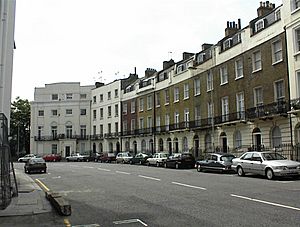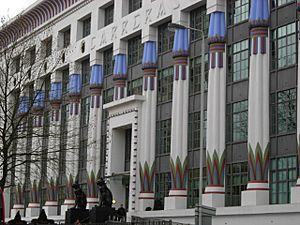Mornington Crescent facts for kids
Mornington Crescent is a famous street in Camden Town, Camden, London, England. It was built a long time ago, in the 1820s. Back then, it was in a green, open area just north of central London.
Over time, many of the big houses were split into smaller flats. The street's shared garden area is now home to the large Carreras Building. The Mornington Crescent tube station, which opened in 1907, got its name from this very street.
Contents
History of Mornington Crescent
Mornington Crescent was named after the Earl of Mornington. He was the brother of the famous Duke of Wellington. The street is shaped like a crescent, which is a curved shape, with three rows of houses.
When it was first built, the crescent had 36 large houses. These homes were perfect for professional people. The area was surrounded by green fields, offering great views. It was also close enough to the city center.
Changes Over Time
Later, things started to change. A railway line was built nearby, leading to Euston railway station. More people moved into the areas around Mornington Crescent. This included places like Kings Cross and Camden Town.
During the Victorian era, the neighborhood became more crowded. Many of the big houses in Mornington Crescent were divided. They became homes for many families, including artists and craftspeople.
The Carreras Building
The large Art Deco building you see today in the crescent's former gardens is called the Carreras Building. It was first built between 1926 and 1928. It used to be a tobacco factory for the Carreras Tobacco Company.
This building is a great example of Egyptian Revival architecture. This style was popular in the early 1900s. It's easy to spot because of the huge bronze statues of the Egyptian cat god Bastet at the front. In the 1990s, the building was updated. It became an office building and was renamed Greater London House.
Mornington Crescent in Art
Mornington Crescent has inspired many artists and writers. The artist Frank Auerbach has a studio nearby. He has often painted the crescent and the area around it.
The street was also a popular subject for the Camden Town Group of painters.
- The painter Walter Sickert lived at number 6 from 1905.
- Spencer Gore lived at number 31 from 1909 to 1912.
- Clarkson Frederick Stanfield, a painter and friend of Charles Dickens, lived at number 36 from 1834 to 1841.
- Another painter, Harden Sidney Melville, also lived at number 34 for a time.
Even Charles Dickens himself had a connection to the area. He went to a school called Wellington House Academy. It was on Granby Terrace, which is right next to Mornington Crescent.



